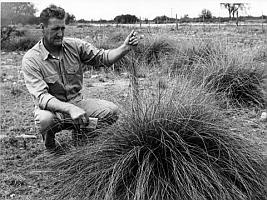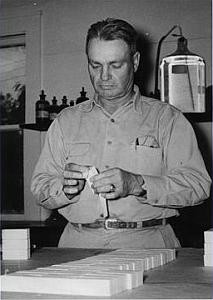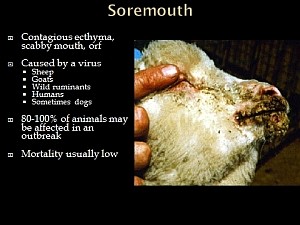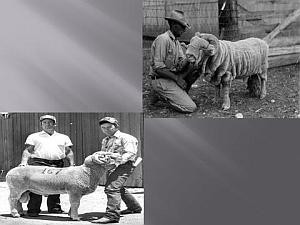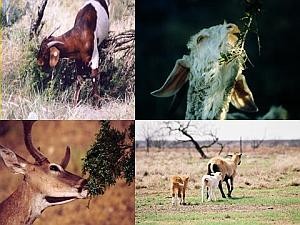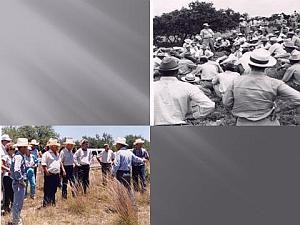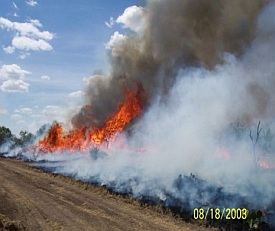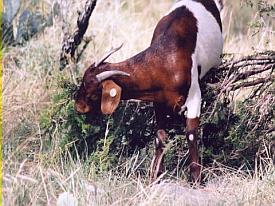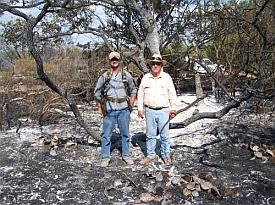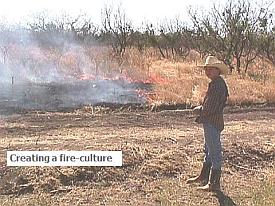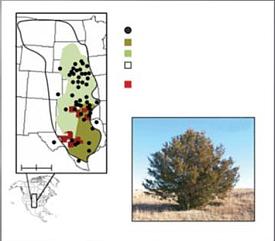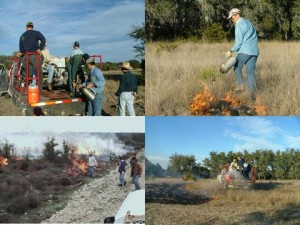Sonora Station is a research facility that is part of the Texas A&M AgriLife’s San Angelo Research and Extension Center. Sonora Station is located about 27 miles south of Sonora, Texas, and is just off State Highway 55 about 28 miles northwest of Rocksprings.
HISTORY
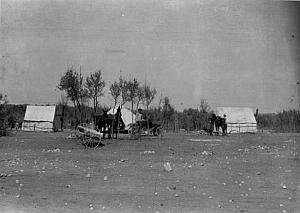
The Texas Agricultural Experiment Station, once known to ranchers as the Ranch Experiment Station and to Texas A&M University as “Substation” Number 14” got its start during the 1915 inaugural convention of the Texas Sheep and Goat Raisers’ Association in Del Rio. The year prior to the convention had been extremely dry in Sutton and Edwards Counties, and several ranching friends struggling through the drought found themselves mysteriously losing their livestock. These farsighted pioneers discussed the possibility of having an experiment station nearby to help them with ranch management problems. The idea quickly gained support from other ranchers and was soon adopted by the fledgling Texas Sheep and Goat Raisers’ Association.
The Association then mustered help from Texas A&M University and the Texas Legislature who quickly established the station later that same year between Sonora and Rock Springs.
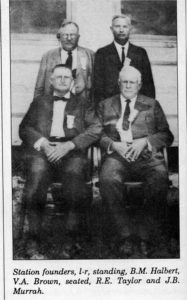 On June 22, 1916, Substation 14 was purchased with equal contributions from area ranchers and the Texas Legislature. Since then this research station has made significant returns on the initial investment to the livestock industry and to rangeland conservation[1]. Shortly after its establishment, the discoveries at the Sonora Station led one of the initial contributors to say, “He gave a hundred dollars at the beginning of the work and he could have easily given a thousand if he had been giving only a small percentage of what the station had saved him.”
On June 22, 1916, Substation 14 was purchased with equal contributions from area ranchers and the Texas Legislature. Since then this research station has made significant returns on the initial investment to the livestock industry and to rangeland conservation[1]. Shortly after its establishment, the discoveries at the Sonora Station led one of the initial contributors to say, “He gave a hundred dollars at the beginning of the work and he could have easily given a thousand if he had been giving only a small percentage of what the station had saved him.”
The initial impetus for establishment of the station was to determine the cause and cure for bighead, a swelling of the head in sheep and goats due to photosensitization that was found to be caused by consuming blooms and fruit of the sacahuista plant. Research on stocking rate demonstrated that proper stocking rate was the key to reducing death loss from consuming this plant. During the first 22 years of the station many other important discoveries were made that supported and improved efficiency of livestock production on the Edwards Plateau. These included studies on other poisonous plants, diet selection by cattle, sheep and goats, nutrition and supplementation, animal breeding, wool and mohair production, and animal diseases. During these early years, a vaccine for sore mouth was developed that is still in use today and over 100 million doses have been sold. One area rancher has said all of the money invested in the station should be considered money well spent if the sore mouth vaccine was the only discovery.
|
|
During the next 20 years (1940 – 1959), research continued on livestock production and rangeland conservation while expanding to include wildlife research, particularly as it related to livestock and white-tailed deer interactions. In 1948 the Rambouillet Central Performance Test was begun to evaluate rams in a common environment. This test is still conducted and we believe that it is the longest running central performance test in the world. Other livestock work was primarily on Rambouillet sheep to improve identification of genetically superior animals. Station Superintendent Dr. Leo Merrill developed the Merrill 3-herd, 4-pasture deferred rotation grazing system during this time period, which was shown to improve range condition and today is still one of the most widely used grazing systems in Texas. Multi-species grazing of cattle, sheep and goats was investigated and shown to provide more uniform utilization of forage. The drought of record (1950 – 1957) occurred during this interval and research was conducted to determine the effect of drought on plant mortality this long-term record allowed for comparison of the 1950’s drought to the drought in 2011, the driest one year on record. These findings were published in 2014.
|
|
The first watershed research was begun during the 1960 – 1979 time frame. Research on grazing management and diet selection continued, including the effect of grazing management on livestock losses caused by toxic plants. Flushing range ewes to increase lamb production was studied and breeding research included the calculation of heritability of production traits of sheep. Interestingly, fine-wool ram performance on pasture and feedlot was compared, a topic of recent renewed interest because of the cost of feed.
From 1980 to 1999, research concentrated on sustainable rangeland production systems, to include the effect of grazing management on livestock, wildlife and watershed production. During this period and shortly before, short duration grazing was being promoted as a method to double the stocking rate on rangelands and ranchers wanted an unbiased assessment of the effect of intensive rotational grazing compared to the conventional grazing management practices. Results showed that stocking rate was a more important determinant of ecosystem response and livestock production than grazing systems. High stocking rates resulted in a loss of mid-grasses, an increase in runoff, and a reduction in livestock nutrient intake and subsequent lower individual animal performance. Runoff was shown to be related to the amount of organic matter cover, a relationship that has been used to model the effect of management on hydrologic processes of rangelands. Toward the end of this time period, the adverse effect of juniper encroachment on rangelands became increasingly obvious and research on the use of prescribed fire and goats to control juniper began in earnest, including the establishment of the Edwards Plateau Prescribed Burn Association in 1997.
From 2000 to present, the main trust of research at the Sonora Station has been the management of juniper, employing a combination of prescribed fire and goat browsing. This research has resulted in new prescriptions for high intensity fires that can be used to restore juniper woodlands to grassland savannas. The prescribed burn associations (PBAs) that began at the station — and that are instrumental in insuring safe prescribed burns, as well as promoting the use of prescribed fire — have grown to over 50 PBAs today, extending from south Texas to Nebraska. The importance of PBAs for restoring degraded rangelands has been recognized with numerous awards, including the Texas Environmental Excellence Award in 2002 and the Lone Star Land Stewardship Award in 2010. Goat browsing is an important biological control for juniper and enhancing the effect of prescribed fire. To that end, much research has been conducted to increase goat preference for juniper by selectively breeding goats to consume more juniper, as well as strategic supplementation to increase its consumption. The station now has a line of goats with the genetic potential to consume about ten percentage units more juniper than when selection began in 2005. The vaccine for sore mouth developed at the station, which had successfully been used for decades to control this disease, has lost some of its effectiveness particularly in Boer goats. Research is being conducted to identify the viral strains responsible for these new outbreaks and develop an effective vaccine.
|
|
Throughout the 100 year history of the station, research focus has changed to address the needs of the clientele while at the same time continuing some of the long-term programs such as central performance tests and production of sore mouth vaccine. The Sonora Station has been a vital contributor to the ecological, economic and social wellbeing of the Edwards Plateau. Many of its strongest supporters are grandchildren of the pioneers that saw the need for the station, lobbied the legislature for its creation and made the financial contribution required for its establishment. These same supporters also recognize the demographic shift that is taking place in much of rural Texas and perhaps more so in the Edwards Plateau than other regions of the state. This recognition has resulted in outreach by the long time beneficiaries of the station in activities such as the Neighbor Meeting Neighbor field day in 2014. As the Sonora Station begins the second hundred years of service to this region, the state and the world, it is your opportunity to get involved and help make the second hundred years better than the first, which, considering all that has already been accomplished, is no small challenge.
[1] In the context of this publication, conservation is the wise use of natural resources, which is the classic definition of this term, in contrast to contemporary uses that often imply preservation, i.e., no use.
